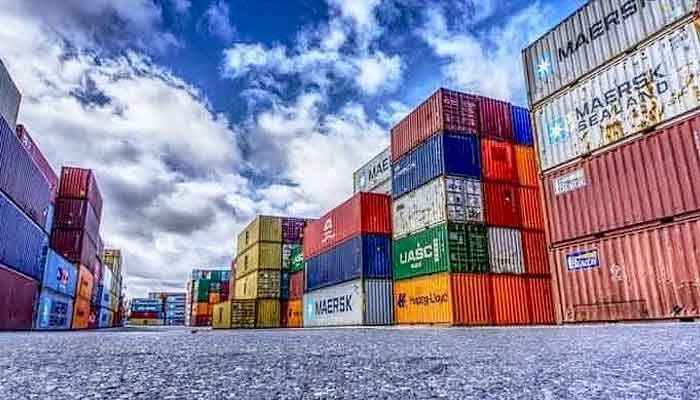Trade deficit shrinks 32.6pc in first half on import curbs
ISLAMABAD: Pakistan’s trade deficit shrinks 32.65 percent to $17.13 billion in the first half of the current fiscal, as imports of non-essentials and other goods were slowed down by over a fifth as compared to last year. This import-export gap was recorded at $25.44 billion in the same period of FY22.
Imports in the July-December period shrank by 22.63 percent to $31.38 billion from $40.56 billion in the same period last year. Likewise, exports were also down by 5.79 percent to $14.25 billion against $15.125 billion in the same period last year, the Pakistan Bureau of Statistics (PBS) monthly trade bulletin said on Tuesday.
In December 2022, exports were down 16.64 percent to $2.3 billion from $2.76 billion in the same month a year ago, while imports dropped 31.9 percent to $5.16 billion from $7.58 billion in December 2021. Trade deficit during the month narrowed down 40.7 percent to $2.86 billion from $4.82 billion in the same month last year.
Comparing monthly trade performance with the previous month (November), goods exports in December 2022 fell 3.64 percent from $2.39 billion in the previous month. Similarly, imports are also down 0.4 percent from November’s imports of $5.18 billion.
The six-month average exports were $2.37 billion against the last fiscal’s monthly average of $2.65 billion, indicating that at the end of FY23, the economy may considerably lag behind even reaching last year’s total exports of $31.79 billion.
However, the average monthly imports during July-December of FY23 were at $5.23 billion, whereas FY22’s average was $6.68 billion.
It is to be noted that in the last fiscal (FY22), the economy accumulated a historic high trade deficit of $48.38 billion, recording above 31 percent increase over the previous year.
The government, in May last, banned import of all non-essential luxury goods in a bid to stabilize the economy as current account deficit has spiralled out of control and foreign exchange reserves have tumbled while the rupee has plummeted to historic lows against the US dollar.
Though the country lifted the import ban on luxury goods in August, such items were heavily taxed to curtain outflow of dollars.
The country’s foreign reserves have fallen to as low as $5.82 billion, barely enough to cover a month of imports.
-
 Mississippi Postal Worker Arrested After Complaints Of Marijuana Odour In Letters
Mississippi Postal Worker Arrested After Complaints Of Marijuana Odour In Letters -
 Canada, China Lock Initial Trade Deal On ‘EV,Canola’ To Strengthen Ties: What To Expect Next?
Canada, China Lock Initial Trade Deal On ‘EV,Canola’ To Strengthen Ties: What To Expect Next? -
 Melissa Leo On Euphoria Of Winning An Oscar Vs It's Impact On Career
Melissa Leo On Euphoria Of Winning An Oscar Vs It's Impact On Career -
 Meghan Markle, Prince Harry Express 'hope' In Latest Major Statement
Meghan Markle, Prince Harry Express 'hope' In Latest Major Statement -
 Sophie Turner Backs Archie Madekwe As BAFTA Announces Nominees
Sophie Turner Backs Archie Madekwe As BAFTA Announces Nominees -
 Jason Momoa Cherishes Hosting Ozzy Osbourne's Final Gig Ahead Of His Death
Jason Momoa Cherishes Hosting Ozzy Osbourne's Final Gig Ahead Of His Death -
 Real Reason Timothee Chalamet Thanked Kylie Jenner At Awards Revealed
Real Reason Timothee Chalamet Thanked Kylie Jenner At Awards Revealed -
 Will King Charles Attend Funeral Of Prince Philip's First Cousin, Princess Irene?
Will King Charles Attend Funeral Of Prince Philip's First Cousin, Princess Irene? -
 'Furious' Prince William Wants Andrew As Far Away As Possible
'Furious' Prince William Wants Andrew As Far Away As Possible -
 Blood Moon: When And Where To Watch In 2026
Blood Moon: When And Where To Watch In 2026 -
 Apple Foldable IPhone Tipped For 2026 Launch With A20 Pro Chip And C2 Modem
Apple Foldable IPhone Tipped For 2026 Launch With A20 Pro Chip And C2 Modem -
 Meghan Lends Credence To Reports Of Rift With Kim Kardashian On Chicago's Birthday
Meghan Lends Credence To Reports Of Rift With Kim Kardashian On Chicago's Birthday -
 Florida Woman’s Alleged Bid To Bribe Police Ends In Unexpected Discovery
Florida Woman’s Alleged Bid To Bribe Police Ends In Unexpected Discovery -
 James Van Der Beek Strongly Opposes The Idea Of New Year In Winter
James Van Der Beek Strongly Opposes The Idea Of New Year In Winter -
 Elon Musk’s Starlink Rival Eutelsat Partners With MaiaSpace For Satellite Launches
Elon Musk’s Starlink Rival Eutelsat Partners With MaiaSpace For Satellite Launches -
 Fans Feel For Leonardo DiCaprio As He Gets Awkwardly Snubbed: Watch
Fans Feel For Leonardo DiCaprio As He Gets Awkwardly Snubbed: Watch




